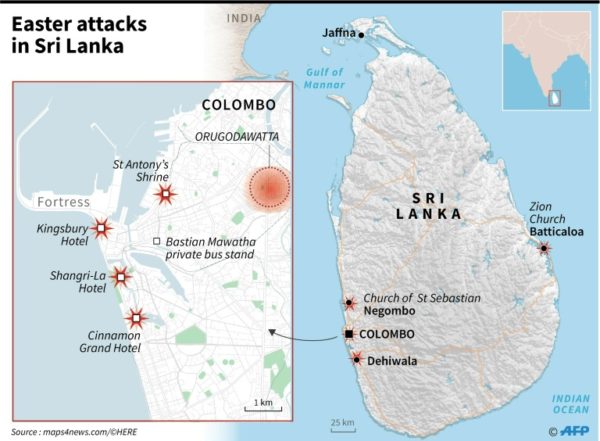What is the issue?
- A series of bomb blasts took place in Sri Lanka, killing close to 300 people and injuring many more.
- The bombings confirm the Islamic State's potent reach in South Asia.
What happened?
- Powerful explosions struck in quick succession at three hotels in the capital Colombo on Easter Sunday.
- Three churches were also targeted in that wave of blasts -
- Colombo's historic St. Anthony's Shrine
- the St. Sebastian's church in the town of Negombo on the western coast, north of the capital
- the Zion Church in the east coast town of Batticaloa
- Early reports suggest that two suspects involved in the attacks are Islamic State (IS) returnees from Syria and Iraq.

What does it suggest of IS?
- The ‘Caliphate’ that Abu Bakr al-Baghdadi established across the Iraq-Syria border has been destroyed. Click here to know more.
- So IS, which controlled huge swathes of territory in Iraq and Syria, is now trying to establish itself in other new territories.
- The Sri Lanka bombings too confirm that the destruction of the physical Caliphate doesn’t end the threat the group poses.
- It has raised concerns about the Islamic State’s expansion into the South Asian region.
- The targets chosen as well as the occasion suggest that the bombings were aimed at gaining maximum global attention.
How is IS expanding?
- From early 2015, when it started losing territories, the IS started shifting its strategy from expanding territorially to expanding insurgency and terror.
- Significantly, South Asia has been one of its key targets.
- In Nangarhar in eastern Afghanistan, the IS set up a wilayat (province).
- From here, it controls its South Asia operations, mainly recruitment of young men from the region.
- Over the last few years, the IS has carried out dozens of attacks in Afghanistan, mostly targeting the Shia-Hazara minority.
- In Pakistan, the Jamaat-ul-Ahrar, a splinter group of the Pakistan Taliban with IS links, carried out several terror attacks.
- It includes the 2016 Easter Sunday bombing in Lahore, targeting Christians.
- In Bangladesh, the IS claimed the July 2016 Holey Artisan Bakery attack.
- In India, it has not carried out any attack but has found dozens of recruits.
What are the emerging challenges for the States?
- Young recruits - The IS had recruited thousands of youth from South Asian nations such as Afghanistan, Pakistan, India and Sri Lanka.
- Some of them joined the wilayat in Nangarhar and others travelled to Iraq and Syria.
- New havens - Now that the Caliphate has been destroyed, thousands of trained militants are left without a place to hide.
- Many of the recruits have retreated to pockets on the Iraq-Syria border or to the deserts in Syria, Iraq and Jordan.
- Several others returned to their own home countries, as in the case in Sri Lanka.
- Another challenge is that the IS still controls some territory in Afghanistan.
- The U.S. had not made much progress on its declared goal two years ago of defeating the IS in Afghanistan.
- Ideology - An equally difficult challenge is to counter the ideological narrative of the IS.
- The old conception that lack of education and poverty breed terrorism does not hold good in the case of the IS.
- Among the Sri Lankan bombers were some from one of the country’s wealthiest families.
- Most of those who travelled to Afghanistan’s IS territories from Kerala were also from upper middle class families.
- So it is the ideology of puritanical Salafi-jihadism that continues to attract the young, disaffected people.
- Thus, any counter-terror strategy, for it to be effective, should have a counter-narrative to the IS worldview, besides the security measures.
Source: The Hindu
